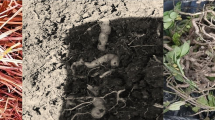Abstract
Lichens represent mutualistic associations between a fungus and one or more extracellularly located photobiont (algae or cyanobacteria). Hypotrachyna cirrhata (Fr.) Divakar et al. and Flavoparmelia caperata (L.) Hale are used ethno medicinally against wound infections, bite and burn, by the folks of Sikkim and Tamil Nadu, India, respectively. Present study was focused on the efficacy of aforementioned lichen extracts against the members of family Enterobacteriaceae. Enterobacteriaceae a heterogeneous family, comprised of coliform bacteria. Genera comprised in this family have evolved drug resistance mechanism against first line clinical drugs. Clinical and Laboratory Standard Institute recommended antimicrobial susceptibility test which was performed to test the susceptibility of pathogens. Acetone extract of H. cirrhata (Fr.) Divakar et al. and F. caperata (L.) Hale was found to be effective against Vibrio cholerae, Klebsiella pneumoniae and Salmonella typhimurium with MIC value 2.48 ± 0.02, 2.24 ± 0.02 and 2.28 ± 0.03 mg/ml; and 3.29 ± 0.06, 4.40 ± 0.05 and 4.96 ± 0.06 mg/ml, respectively. The aforementioned lichens showed promising antibacterial activity and provided new tools to develop novel drugs.



Similar content being viewed by others
References
Hawksworth DL (2000) Freshwater and marine lichen-forming. In: Hyde KD, Ho WH, Pointing SB (eds) Aquatic mycology across the millennium, vol 5. Fungal Diversity, Hong Kong, pp 1–7
Singh KP, Sinha GP (2010) Indian lichens: an annotated checklist. Botanical Survey of India, Kolkata, pp 181–187. ISBN 978-81-8177-036-3
Upreti DK, Chatterjee S (2007) Significance of lichens and their secondary metabolites: a review. Fungi 2:169–188
Divakar PK, Crespo A, Nunez-zapata J, Flakus A, Sipman HJM, Elix JA, Lumbsch HT (2013) A molecular perspective on generic concepts in the Hypotrachyna clade (Parmeliaceae, Ascomycota). Phytotaxa 132(1):21–38
Saklani A, Upreti DK (1992) Folk uses of some lichens in Sikkim. J Ethnopharmacol 37:229–233
Hale ME (1986) Flavoparmelia, a new genus in the lichen family Parmeliaceae (Ascomycotina). Mycotaxon 25:604
Rajan S, Jayendran M, Sethuraman M (2005) Folk herbal practices among Toda tribe of Nilgiri Hills in Tamil Nadu India. J Nat Rem 5(1):52–58
Taylor PW (2013) Alternative natural sources for a new generation of antibacterial agents. Int J Antimicrob Agents 42:195–201
Sleigh JD, Duguid JP (1989) Enterobacteriaceae: Escherichia, Klebsiella, Proteus and other enterobacteria. In: Collee JG, Duguid JP, Fraser AG, Marmion BP (eds) Mackie and MeCartney’s Practical Medical Microbiology, vol II, 13th edn. Churchill Livingstone, pp 432–455
Gillies RR (1984) Gillies & Dodds bacteriology illustrated/revised by RR Gillies, 5th edn. Churchill Livingstone, Edinburgh, New York, pp 2–89
Johnston JM, McFarland LM, Bradford HB, Caraway CT (1983) Isolation of nontoxigenic Vibrio cholerae O1 from a human wound infection. J Clin Microbiol 17(5):918–920
Sanchez GV, Master RN, Clark RB, Fyyaz M, Duvvuri P, Ekta G, Bordon J (2013) Klebsiella pneumoniae antimicrobial drug resistance, United States, 1998–2010. Emerg Infect Dis 19(1):133
McHugh GL, Moellering RC, Hopkins CC, Swartz MN (1975) Salmonella typhimurium resistant to silver nitrate, chloramphenicol, and ampicillin. Lancet 1(7901):235
CDC (2013) National antimicrobial resistance monitoring system for enteric bacteria (NARMS): Human isolates Final Report, 2011. Atlanta Georgia: U.S. Department of Health and Human Sevices, CDC
Hohmann EL (2001) Nontyphoidal Salmonellosis. Food safety CID available from http://cid.oxfordjournals.org/. Accessed Feb 2014
Walder MK, Mekalanos JJ (1994) ToxR regulates virulence gene expression in non-O1 strains of Vibrio cholerae that cause epidemic cholera. Infection and immunity 62(1). http://iai.asm.org/. Accessed Sept 2014
Public Health Agency of Canada (2011) Pathogen safety data sheet—infectious substances. http://www.phac-aspc.gc.ca/lab-bio/res/psds-ftss/vibrio-cholerae-eng.php. Accessed Sept 2014
Zarkotou O, Pournaras S, Voulgari E, Chrysos G, Prekates A, Voutsinas D, Themeli-Digalaki K, Tsakris A (2010) Risk factors and outcomes associated with acquisition of colistin-resistant KPC-producing Klebsiella pneumoniae: a matched case-control study. J Clin Microbiol 48:2271–2274
Turnidge J (2005) Multi-drug resistant enterobacteriaceae. Int J Antimicrob Agents 26:S44
Lee C (2008) Therapeutic challenges in the era of antibiotic resistance. Int J Antimicrob Agents 32(S4):S197–S199
Awasthi DD (2007) A compendium of the Macrolichens from India, Nepal and Sri Lanka. Bishen Singh Mahendra Pal Singh, Dehra Dun, pp 10–19. ISBN 978-81-211-0600-9
Baral B, Maharjan BL (2011) Assessment of antimicrobial and phytochemical potentials of high altitudinal Nepalese Lichens. J Microbiol Biotechnol Food Sci 1(2):98–112
Wilker MA, Low DE, Cockerill FR, Sheehan DJ, Craig WA, Tenover FC et al (2006) Methods for dilution antimicrobial susceptibility tests for bacteria that grow aerobically; approved standard-seventh edition, vol 26. Clinical and Laboratory Standards Institute (CLSI) M7-A7, Wayne
Plotly, Inc. https://plot.ly/. Accessed 29–30 Nov 2014
Eloff JN (2000) A proposal on expressing the antibacterial activity of plant extracts—a small first step in applying scientific knowledge to rural primary health care in South Africa. S Afr J Sci 96:116–118
Eloff JN (2004) Quantifying the bioactivity of plant extracts during screening and bioassay-guided fractionation. Phytomedicine 11:370–371
Cos P, Vlietinck AJ, Berghe DV, Maes L (2006) Anti-infective potential of natural products: how to develop a stronger in vitro ‘proof-of-concept’. J Ethnopharmacol 106:290–302
Acknowledgments
Thanks are due to the Head, Department of Botany, University of Allahabad for laboratory facilities, Dr. D.K. Upreti, Deputy Director, National Botanical Research Institute (NBRI), Lucknow, for identification of lichens, Dr. G.P. Sinha, Head, Botanical Survey of India, Central Regional Centre, Allahabad for accepting the voucher specimens of Lichens and University Grant Commission (UGC) New Delhi, India, for financial assistance.
Conflict of interest
The authors have no conflict of interest.
Ethical Approval
Ethical approval was not required in the present study.
Author information
Authors and Affiliations
Corresponding author
Rights and permissions
About this article
Cite this article
Pathak, A., Shukla, S.K., Pandey, A. et al. In Vitro Antibacterial Activity of Ethno Medicinally Used Lichens Against Three Wound Infecting Genera of Enterobacteriaceae. Proc. Natl. Acad. Sci., India, Sect. B Biol. Sci. 86, 863–868 (2016). https://doi.org/10.1007/s40011-015-0540-y
Received:
Revised:
Accepted:
Published:
Issue Date:
DOI: https://doi.org/10.1007/s40011-015-0540-y




